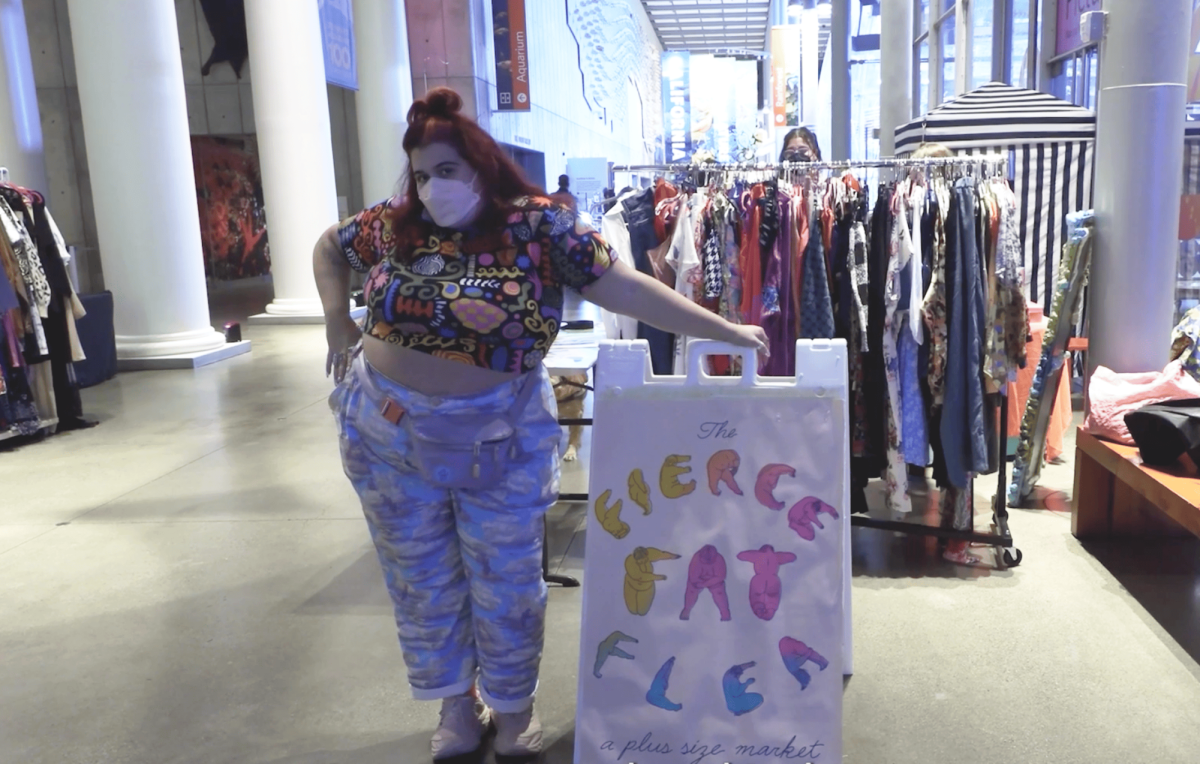G.V. Kelley takes a big square of brown clay out of a dusty closet, puts on an apron and begins molding. Slowly ripping apart pieces of clay, Kelley forms a head while also completing a body form made up of breasts and a round butt. Within just 10 minutes, Kelley has sculpted a big brown square of nothing into something.
Kelley, 28, is an SF State post-baccalaureate student with an undergraduate degree in ceramics sculpture. Kelley was invited to stay on the program following graduation to prepare for Kelley’s graduate portfolio and build experience.
Kelley started ceramics sculpture after graduating from high school, but has been sculpting and building things more or less for Kelley’s whole life.
“As a kid I kind of had a wild imagination and wanted to physically see the things I would imagine in my head,” Kelley said. “I also really found most toys really disappointing, and I wanted to make ones that I like that suited my desires and needs as a child.”
While Kelley’s art is an avenue for Kelley’s instinctive imagination, it also serves as an outlet.
Kelley identifies as a gender non-binary, which is a gender identity that doesn’t fit within the accepted binary of male or female. People can feel they are both male and female, neither or some mixture thereof. Instead of being referred to as “he” or “she,” non-binary persons prefer to be referred to as “they.”
“It’s been a source of struggle for me for a long time,” Kelley said. “It’s a difficult thing to explain so I don’t really talk about it with people who, you know, I don’t think are going to understand.”
Kelley said their identification comes out in their work because that’s how they best process that struggle.
“It’s also a way to relate to other people about it and it’s been surprising how people relate to that in so many ways, just gender and gender identity,” Kelley said.
Kelley’s art is primarily figurative, much of which appearing as human bodies with animal heads. Kelley explained that they like to anthropomorphize parts of animals and conjoin them with human bodies and forms.
“I don’t see a line between humans and animals because humans are animals,” Kelley said. “I want to emphasize that.”
Kelley talked about queer symbolism expressed in their artwork. Queerness, meaning deviations from heteronormativity in terms of gender and sexuality, can often be seen as having higher powers and social standing in other cultures. Kelley uses these ideas through the use of animal heads because they want to relate to that mythological quality of otherness, and celebrate diversity as something powerful.
“One of my favorite things to do is having two figures interacting with each other,” Kelley said. “I just feel like it’s so loaded with symbolism. Just how people relate to each other, how we relate to bodies, how bodies are viewed in this society, what bodies are worth more than other bodies, what bodies are queer bodies and what bodies are the idolized bodies and why.”
Rory Hejtmanek, 27, lives with Kelley and said his favorite piece is titled, “Pieta,” of which a sitting human body is holding a dead baby human body, and both figures have caribou heads.
“I’ve seen them (Kelley) working, they’ll be sitting and fiddling with things,” Hejtmanek said. “Then all of a sudden it’s this magical piece. It’s like they’re so nonchalant about how talented they are.”
Kelley’s pieces have been displayed in various galleries since graduation and some have even been purchased. Kelley said they enjoy remaining anonymous when their art is on display, because it’s fascinating listening to reactions when people are unaware the artist is around.
One of Kelley’s pieces titled, “Suture,” is a pale figure sitting cross legged with a human face and a blue a frame haircut covering most of the face except for the lips. The figure is curvy with wide hips, a big butt, flat chested, an adams apple and heart shaped nipples. Down the front of the figure from the top of its chest to the bottom of its naval is a large gash, which is intended to look like a vagina. The figure is holding a needle and sewing up the wound.
Kelley explained it was designed to look like both a wound and a vagina, illustrating Kelley’s mixed ideas of femininity and what it means to have a vagina. While Kelley had their own idea of what the piece meant, they also wanted it to relate to other people who aren’t necessarily assigned as female at birth.
During a showing of this piece at a gallery they said that a lot of the viewers were shocked and horrified by this piece and what it looked like.
“I was like good,” Kelley said. “I don’t want people to think things are cute or pretty, I want them to have to think about it. If it’s weird or horrifying, if that’s what it takes to get people to think about it, then that’s what it takes.”
Jeff Perkins, 24, is a studio art major at SF State. He works at the desk next to Kelley and has seen a lot of their work over the years.
“I think G’s art speaks to a purist, tribal instinct we all have,” Perkins said. “They bring out the dark tendencies that we all have as humans.”
Kelley said through art they hope to invoke a sense of validation in people. They ultimately want people to see their artwork and feel better about who they are. If people can’t identify with it, Kelley wants them to at least find an understanding with what it represents.
“Either it’s beautiful or you know, this is a complex facet of humanity,” Kelley said. “Either way, I just want people to accept it for what it is.”










